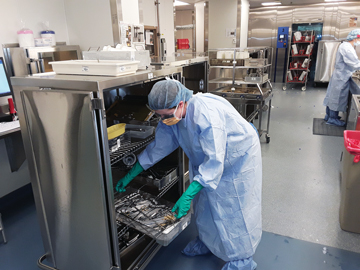Surgical staff members understandably have an expectation that they will receive clean and sterile instruments from sterile processing. For a true partnership to exist between the two areas, however, you need to instill an expectation that
sterile processing techs will receive instruments from ORs that have been wiped down during and immediately after procedures, and shipped to them moist. Creating that partnership and making sure it's a two-way street not only makes it
easier for the OR staff to get the clean instruments they want, it also means instruments are properly cared for and patients will receive the quality care they deserve.
The primary reasons facilities skip point-of-use instrument care are related to time and money. The pitch to OR staff is that the rewards and benefits outweigh the few extra minutes pre-cleaning takes. A well-cared-for stainless steel surgical
instrument can last more than 10 years, which helps your facility's bottom line because you won't have to replace pitted instruments that are no longer usable. Pre-treatments also shorten the time sets spend in decontamination, which saves
money and results in fewer late case starts that waste expensive OR time.
Wiping instruments with water and gauze during procedures and making sure they remain moist until they reach sterile processing should be a no-brainer. The extra steps will add a few minutes to room turnover times, but overall efficiencies will improve
because instruments arrive at sterile processing with no bioburden on their surfaces, making them easier to clean and sterilize. Reprocessing techs will therefore be able to return sets of properly cared-for instruments to ORs at a faster
clip. Point-of-use instrument care is particularly important for instrument sets used multiple times a day for high-volume procedures. It's important during the introduction of point-of-use care to help OR staff understand the "why" behind
what they're being asked to do. When rolling the concept out, include point-of-use protocols in your facility's policies and enlist members of the surgical staff to deliver the message to their colleagues. Be sure the OR staff knows that
national, evidence-based standards recommend the point-of-use care of surgical instruments. Ongoing compliance review is equally important to ensure the protocols are followed consistently. I recommend that point-of-use care be included
in your facility's annual competency assessments.
Point-of-use care isn't yet universal, but it's heading in that direction. The Joint Commission updated their standards two years ago to make the practice a requirement (IC.02.02.01.02) and surveyors are checking for compliance. During your next survey,
don't be surprised if the surveyor walks into the decontamination area and opens a case cart to see if instruments have been sprayed with pre-treatment gel.
I've worked in three hospitals over the last 12 years, and they followed the same track: They learned about point-of-use instrument care, then trained their employees on how to do it and now it's a mandatory policy. As your facility gets on
the same trajectory, you'll have a smoother running OR schedule, will pay less for instrument repairs and keep your patients as safe as possible. OSM
.svg?sfvrsn=be606e78_3)

.svg?sfvrsn=56b2f850_5)